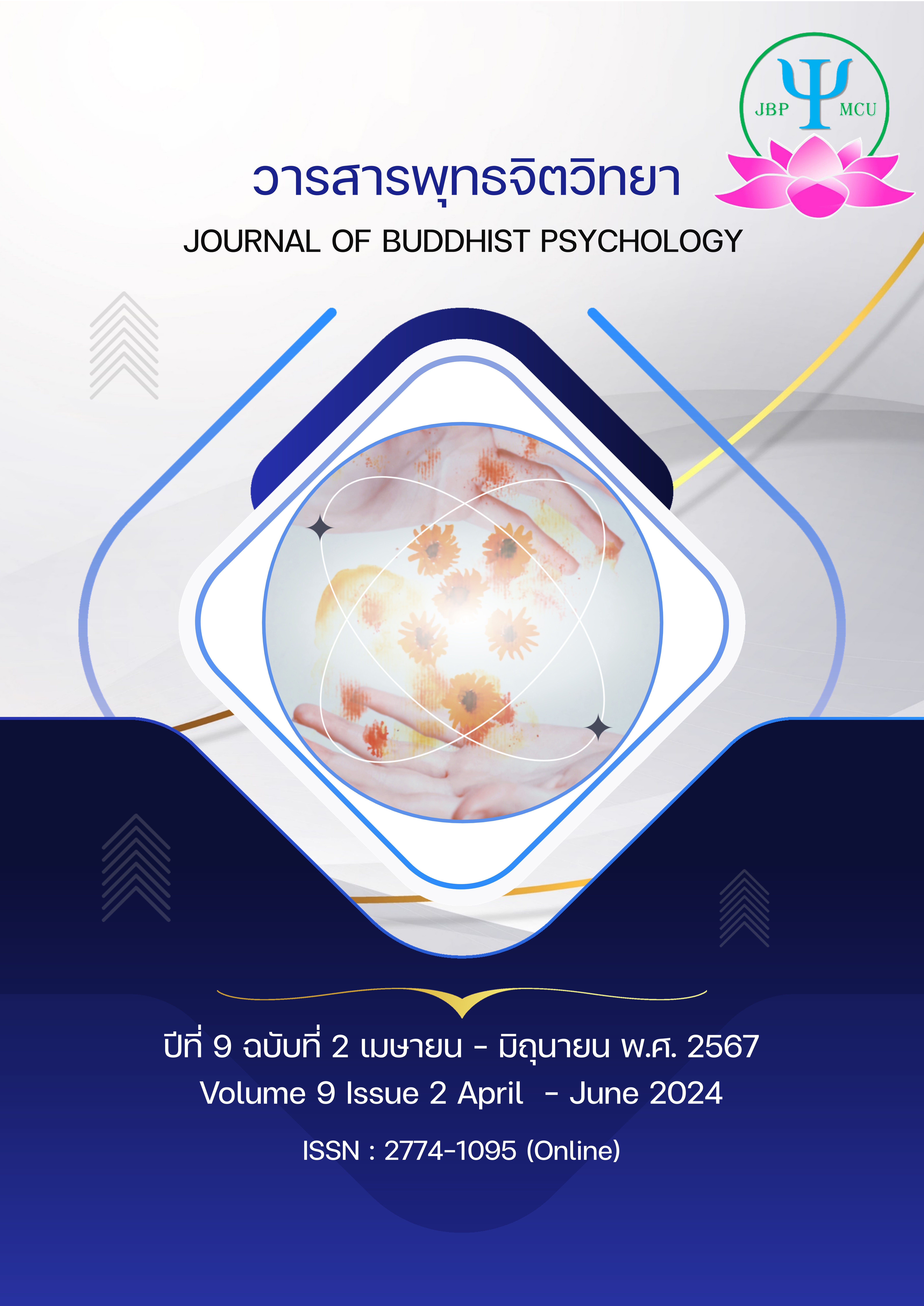Breath Awareness: Creative Media Design Process for Enhancing Resilient Quotient Based on Buddhist Psychology
Main Article Content
บทคัดย่อ
This research aims to achieve the following objectives: 1. Explore and Produce media based on the principles of Buddhist Psychology to increase awareness of breathing. 2. Examine the production process of creative media in enhancing breath awareness and resilience quotient. The theories and framework for this research were derived from Dhātu 4 (The Four Elements) and Bala 5 (The Five Powers), which were used to create a resilient quotient for the design process. Additionally, a psychological theory involving cognitive and behavioural therapy was employed to create a learning experience that induces mental changes. The methodology used in this research was a mixed-methods approach such as questionnaire, and the evaluation of resilience quotient. The analysis of the data included mean, standard deviation, and paired-sample t-test. The final research found that the media design process of breath awareness into three rooms in one hour received an overall high level of approval from the 30 participants, with an average score of 4.01 and a standard deviation of 0.705. Additionally, breath awareness increased the students’ resilience quotient by an average score of 3.13 points. Of the 30 students, 23 showed an increase in resilience quotient (79.97%), while 6 students scored less on the assessment (20%) and 1 student had a stable score.
Article Details

อนุญาตภายใต้เงื่อนไข Creative Commons Attribution-NonCommercial-NoDerivatives 4.0 International License.
เอกสารอ้างอิง
Heck, E., &Tsai, M., (2022). Sharing therapeutic experiences of place: Co-creative digital storytelling as a way to explore connection to place. Emotion, Space, and Society, 43, 100879.
Hunkin H., King D.L., Zajac I.T. (2021). EEG Neurofeedback During Focused Attention Meditation: Effects on State Mindfulness and Meditation Experiences. Mindfulness, 12, 841–85.
Jayaraj, P.J., Ghazali, M., & Gaber, A. (2021). Relax App: Designing Mobile Brain-Computer Interface App to Reduce Stress among Students. International Journal of Innovative Computing, 11(2),7-13.
DeMaranville, J., Wongpakaran, T., Wongpakaran, N., & Wedding, D. (2022). Meditation and Five Precepts Mediate the Relationship between Attachment and Resilience. Children, 9(3), 371.
Department of Mental Health. (2020). Strong Together. Bangkok: Beyound publishing.
Dufour, C., Kamau, D., Michel, P., Prete, H., & Stewart, S. (n.d.). Resilience meditation. Retrieved from Meditaion studio by muse: https://meditationstudioapp.com/collections/C73
Gadetragoon, P., Srikhruedong, S., & Phoowachanathipong, K. (2022 ). Buddhist Psychology for Adolescent’s Mind Power. Buddhist Psychology Journal, 7(2),79-88.
Guido, A. (2023). Equity-centered trauma-informed pedagogy in art education (Master’s Thesis). James Madison University.
Haller, K. (2019). The Little Book of Colour: How to use the psychology of colour to transform your life. UK: Penguin Life.
Hankitrung, A. (2016). Buddhist Psychology for self-development. Buddhist Psychology Journal,1(2), 30-38.
Hemmings, J. (2022). How Psychology Works. Bangkok: Wara Publishing Co.,Ltd.
Huberty, J., Green, J., Glissmann, C., Larke, L., Puzi, M., & Lee, C. (2019). Efficacy of the Mindfulness Meditation Mobile App “Calm” to Reduce Stress Among College Students: Randomized Controlle Trial. JMIR mhealth and uhealth, 7(6),14273.
Kelly, B. D. (2008). Buddhist Psychology, Psychotherapy and the Brain: A Critical Introduction. Transcultural Psychiatry, 45(1), 5–30.
Kim, S., Gäbel, C., Aguilar, C., Hilleck, T. K., & Warth , M. (2018). Affective and autonomic response to dynamic rhythmic entrainment: Mechanisms of a specific music therapy factor. The Arts in Psychotherapy, 60, 48–54.
Kleinman, P. (2022). Psych 101: Psychology fact, basic,statistics, test and more. Nontaburi: Arrow.
Koike, R. (2020). Kangaenai Renshu. Bangkok: Amarin Dhamma.
Kozhevnikov, M., Chen, J. Y., & Blazhenkova, O. (2013). Creativity, Visualization Abilities, and Visual Cognitive Style. British Journal of Educational Psychology, 83, 196-209.
McKenzie , S. B. (2022). Mindfulness Meditation for Student Success: The Impact of a Virtual Meditation Group on Community College Student Stress Coping, Resilience, and Persistence. USA: Bradley University.
Nave, O., et al. (2021). Self-Boundary Dissolution in Meditation: A Phenomenological Investigation. Brain Sciences, 11(6), 819.
Nestor, J. (2021). Breath: The new science of a lost art. UK: Penquin Random house.
Phophichit, N., Phramaha Hansa Dhamahaso, & Ruksat, S. (2019). The Effect of Buddhist Psychological Factors on the Resilience of Adolescent in Bangkok. The Journal of the International Association of Buddhist Universities, 12(1), 353-368.
Phra Phom Kunaphorn. (2014). Buddha Dham. Bangkok: Chula Longkorn Rajavitayalai.
PhraBrahmapundit. (2022, March 21). Buddhist Psychology. Retrieved March 21, 2022, from https://www.youtube.com/watch?v=f2l-rVgA_XY
Phrakru Sumetpatumaphon. (2021). A Study of the Four Dhatus and Kammatthana Practice in Buddhism. Academic MCU Buriram Journal, 6(2), 158-167.
Phramaha Ponkit Bhuripanno, & Klomkul, L. (2018). A Spirit Reinforcement on Buddhist Psychology. The Joulnal of Institute of Trainner Monk Development, 1(2), 44-60.
Phramaha Sophon Vijittamadhammo & Nakorn, P. N. (2017). Buddhist Psychology and Human's Behavior Change through Foundation of Mindfulness Principles. Buddhist Psychology Journal, 2(2),59-72.
Phungkate, S., (2019). The Light of Life Power. Bangkok: Graduate School, Silpakorn University.
Raynold, L., et al. (2020). Virtual Nature as an Intervention for reducing Stress and Improving Mood in People with Substance Use Disorder. Journal of Addiction, 1, 1-7. https://doi.org/10.1155/2020/1892390
Rockwood, L. (2018, December 11). Change Your Breath,Change your Life. Retrieved from TedExBarcelon: TEDxBarcelon: https://www.youtube.com/watch?v=_QTJOAI0UoU
Samji, H., Wu, J., Ladak, A., & Vosse, C. (2021). Mental health impacts of the COVID-19 pandemic on children and youth – a systematic review. Child and Adolescent Mental Health, 27(2),173-189.
Shams, L., & Seitz, A. R. (2008). Benefits of multisensory learnin. Trends in cognitive sciences, 12(11), 411-417.
SomdetPhraYanawachirodom. (2016). Principle in master of meditation. Bangkok: Willpower Institute.
Taoka, M. (2016). The power of color. Bangkok: Free Mind.
Vuchansu, J. N. (2022). Using Hatha Yoga as Adjunctive Therapy for the Treatment of Major Depressive Disorder in Young Adults (18 to 25 Years). California: University of Massachusetts Global.
WHO. (2023, August 23). Suicide. Retrieved from World Health Organization: www.who.int/news-room/fact-sheets/detail/suicide
Xu, Y., Yang, G., Yan, C., Li, J., & ZhangJi, J. (2022). Predictive effect of resilience on self-efficacy during the COVID-19 pandemic: The moderating role of creativity. Frontiers in Psychiatry,13,1-12.
Yaribeygi, H., Panahi, Y., Sahraei, H., & Sahebkar, A. (2017). The impact of stress on body function: A review. EXCLI J.,16, 1057–1072.


